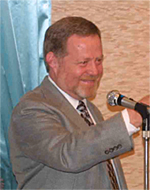|
|
 |
 |
 |
| 1.About GPSC@@2.Goals
of GPSC@@3.About Dr. Donald Lee Spence@@4.Staff
members |
 |
 |
 |
Welcome to GPSC of Hiroshima
University. Thank you very much for visiting us.
We, the members of Hiroshima University, have been working on
various projects individually or in a group, to tie Japan and
the U.S. as global partners. To succeed to and develop the outcomes
of our projects, we founded GPSC supported by US-Japan Foundation.
The biggest incentive for us to found this center was to succeed
to the will of the late Dr. Donald Spence, who studied at Hiroshima
University, played a pivotal role as a bridge between Japan
and the U.S. for a long time and above all, who was a good friend
of ours. We, the close friends of Dr. Spence gathered and decided
to succeed to his will at Hiroshima University.
GPSC plans to develop and foster the leaders who can promote
global partnership in the future and they can be students, teachers
or anyone who can work on school to school projects. And we
also would like to develop various programs for the purpose
above. This is a big and urgent need in education of today and
near future since the globalization of the world is proceeding
in such a rapid speed. And we believe developing the leaders
and programs to foster leaders will contribute to the realization
of the global support system over country borders for the world
peace, which was the hope of Dr. Spence.
 |
Our philosophy is to spread the spirit
of Hiroshima; gPursuit of peaceh by developing people
with global mind and communication skills like Dr. Spence.
We appreciate your support and cooperation. Thank you.
Tomoyuki Kobara, Project Director |
|
 |
 |
 |
The goal of GPSC is to develop
mutual communication and understanding between teachers, students
and pupils of Japan and the U.S. through various international
activities. To pursue this goal, we endeavor to realize the
following objectives:
| 1) |
Information Dissemination: Build GPSC
web-site to disseminate the information on the outcomes
of the previous, on-going, and prospective projects carried
out in Japan and the U.S |
| 2) |
Human Resources Development: Hold workshops
for developing global leaders in education, assisting
mutual exchanges and visitations by school teachers, students
and pupils, overseas classroom observation and teaching
practicum schemes by university students in teacher education
program, and so on. |
| 3) |
Program Resources Designing: Design
and develop global education materials, develop and test
global teaching/learning methods, and help to establish
the methodology of starting a school-to-school relationship
through the joint research and workshops by teachers of
Japan and the U.S. |
|
 |
| |
 |
We founded this center succeeding
to the will of the late Dr. Spence.
Dr. Spence earned his doctoral degree at the
University of Tennessee, and he also studied at the Graduate
School of Education at Hiroshima University for two years under
a Fulbright Grant. After having taught social studies at public
schools of Tennessee and North Carolina, Dr. Spence worked for
North Carolina Department of Public Institution in social studies
education. From 1983 until when he passed away in 2004, he had
served as a member of the East Carolina University faculty.
During the time, he had also worked as director of East Carolina
Japan Center East.
Furthermore, Dr. Spence worked as director (1999-2002)
of two large projects supported by US-Japan Foundation and introduced
on our center website: gCurriculum development to understand
the society and culture of the U.S.h and gGlobal partnership
schools: A model for US-Japan educational collaboration in the
21st Century.h With various services including these, Dr. Spence
played a role of a bridge between Japan and the U.S. Thanks
to his contributions, there is a countless number of people
who acquired a global mind as well as who got involved in fostering
the global mind.
 |
Needless to say, Dr. Spence did not hope
for mutual understandings only between the U.S. and Japan.
He also strongly hoped for mutual understandings in the
world and for the achievement of peace with respect and
love. On his gravestone, letters of gpeaceh (heiwa) are
carved in Japanese. Succeeding to his will, we have founded
Global Partnership School Center and we wish from the
bottom of our heart that this center will help achieve
what he had hoped to achieve. |
|
 |
 |
 |
| (1) Project director: |
Tomoyuki Kobara (Project
representative, Hiroshima University) |
 |
| (2) Collaborators: |
Seiji Fukazawa (Human
Resources Development, Hiroshima University)
Atsushi Asakura (Program Resources Designing, Hiroshima
University)
Takaya Kohyama (Information Dissemination, Hiroshima University) |
 |
| (3) Research cooperators: |
Yasuhiro Ohmatsu (Vice
Principal at Shinonome Elementary School attached to Hiroshima
University)
Yoshio Sumoto (Shinonome Elementary School)
Kazuyki Kambara(Shinonome Junior High School)
Hiroaki Kanoe (Shinonome Junior High School)
Nobutaka Ishii (Mihara Elementary School)
Naohisa Ishihara(Mihara Elementary School)
Kazushige Kimoto (Vice Principal at Mihara Junior High School)
Saori Matsuo (Mihara Junior High School) |
 |
| (4) Overseas collaborators: |
Carolyn Ledford (East
Carolina University, USA)
Betty Peel (East Carolina University, USA)
Anna Lyon (East Carolina University, USA) |
 |
| (5) Research advisers: |
Hideki Yonekawa (Osaka
Kyoiku University)
Akira Ninomiya (Executive and Vice President(Research),
Hiroshima University)
Shinji Ishii (Professor, Hiroshima
University) |
 |
| (6)Evaluators: |
Yasushi Mizoue(Retired President of Naruto University of Education)
Masaki Sakagoshi(Dean of Graduate School of Education, Hiroshima
University)
Marilyn Sheerer(Vice President, East Carolina
University, USA) |
|
 |
|
|
|

